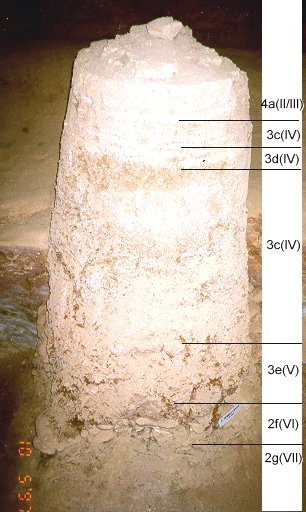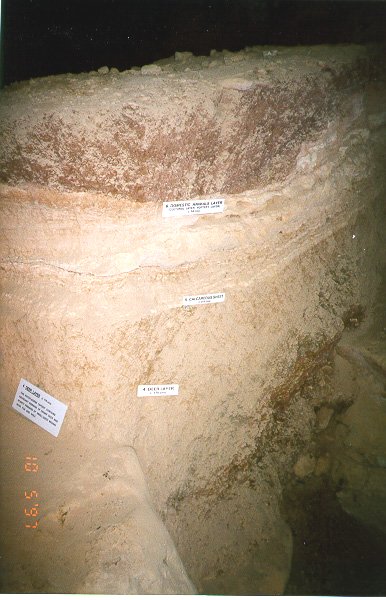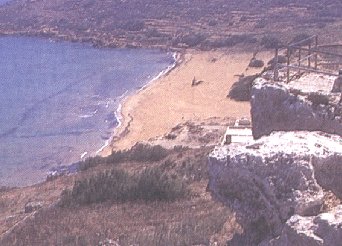 SHORE DEPOSITS - Maghlaq Region
|
The area south of the ice caps did not suffer directly from the glaciation of the Pliestocene, but rather suffered from a series of Pleuvial Periods. Each Pleuvial Cycle can be sub-divided into three subphases.
A: Decreased summer and increased winter radiation. Summer cooler than today. Precipitation less restricted to spring and autumn. Central european forest extends into the Mediterranean region. Ice-cap growing in the north of Europe - PSEUDO-PLUVIAL
B: Greatest extension of ice-sheets in Norther Europe. Summer radiation increasing, winter radiation decreasing. Unsettled weather in summer with much rain and rapid intense temperature changes. Winters cold. Pluvial in Mediterranean area south of approximate 40oN latitude. Effected by weaker phases.
C: Period of disintegration of glacial anticyclone. Total Mediterranean precipitation decreasing. Rapid return to present day type Mediterranean climate.
During the glacials the Mediterreanen region was relatively arid
and poorly vegatated, though the glacials were puctuated by episodic rain
showers. During the interglacial stages, the climate was more humid and
the vegetation was well developed. From the above schematization of the
Pleuvial Cycles and the absence of glaciation in the Mediterranean region,
it is evident that deposits of moraines, loess and frost soils are impossible
to find on the Islands, and hence the Post-Miocene deposits are limited
to:
a] alluvial deposits
b] cave deposits, and
c] soil and sand deposits
The most important type of terace is the Climatic Terrace resulting
from oscillations of the water supply, the alluvial load being chiefly
carried during periods of floods and is thrown down when these subside.
During periods of humid climate, the river flows through a country covered
with vegitation and consequently carries little rock-waste. The river hence
erodes its bed by down-cutting. During dry, arid or semi-arid climate,
the country is barren and the rock more exposed. Fluctuations between a
dry and wet climate results in aggradation terraces.
 SHORE DEPOSITS - Maghlaq Region
|
 |
 |
An important cave site which has been extensively studied is Ghar
Dalam at Birzebbugia. This cave was formed as a result of the erosive properties
of underground water, but was later exposed to outside influence by the
erosive action of surface waters. The cave floor thus exhibit a range of
deposits from normal cave deposits with/without surface influence, and
alluvial deposits. After excavations of the 14-foot thick cave floor, the
stratigraphy was found to be divided into eight main layers outlined in
Table 1.
|
|
|
|
|
|
|
|
|
|
|
|
|
|
|
|
|
|
|
|
|
|
|
|
|
|
|
|
|
or Cervus Stage |
|
|
|
|
or Cervus Stage |
|
|
|
|
or Carnivora Stage |
|
|
|
|
or Carnivora Stage |
|
|
|
|
or Gliridae Stage |
|
|
|
|
or Gliridae Stage |
|
|
|
|
|
The stratification of the Ghar Dalam floor makes a chronological
order possible dividing the floor into four different palaentological layers.
A: Maltamys sp. Stage - The oldest palaentological layers includes
the Bone Brecchia and Pebble. The fossil remains include dwarf hippopotami,
dwarf elephant, giant land tortoises, giant gliridae, shrew and several
bat endemic species. Avian remains, including endemic species were also
represented.
B: Pitymys melitensis Stage (lower) or Carnivora Stage - This
faunal stage is characterised by hippopotami, elephant and Cervus remains.
In addition remains of wolves, foxes, and bear have also been described.
C: The third strata includes the Upper Red Earth layers - Pitymys
melitensis Stage (upper) or Cervus Stage. This consists chiefly of deep
vegetable soil with a number of alternating whitish and brownish layers.
Excavations yielded numerous fossil remains of dwarf deer, boar, bats,
rodents including the endemic Giant Dormouse, and several kinds of birds.
While this layer yielded few endemic species, many of the animals found
here are now extinct from the Islands.
D: The fourth superficial strata included remains from prehistoric
times and contained remains of man and his artefacts, domestic animals
and remains of recent type animals.
1. Wind action
2. Sea action
3. Crushing action
 The
process involved in the deposit's formation may be deduced by classifying
the sand grains according to their roundness as seen through a low power
microscope. Sands formed by wind action are usually rounded; those by sea
action are subangular to subrounded being prevented from becoming exact
spheres by the cushioning effect of the sea. Those formed by a crushing
action are angular. The sand deposits in the Maltese islands are generally
limited to beaches and exhibit the influence of sea action. At least three
types of sands can be identified on the Islands characterized by their
particle size and colour:
The
process involved in the deposit's formation may be deduced by classifying
the sand grains according to their roundness as seen through a low power
microscope. Sands formed by wind action are usually rounded; those by sea
action are subangular to subrounded being prevented from becoming exact
spheres by the cushioning effect of the sea. Those formed by a crushing
action are angular. The sand deposits in the Maltese islands are generally
limited to beaches and exhibit the influence of sea action. At least three
types of sands can be identified on the Islands characterized by their
particle size and colour:
1. a fine reddish-yellow sand (eg. Ramla bay; Golden Bay)
2. a moderate particle size greyish sand (eg. Ghadira Bay)
3. a large particle size white sand (eg. Qala Bay; Blue Lagoon Bay)
 |
The soil is made up of the bed-rock by various climatic and geological actions. These include those which break down the underlying bed-rock to fine powder including water/wind erosion; cracking dur to freezing, high temperatures and plant roots growing in rock cracks; fungal action; and geological movements like faulting and sinking. Various changes then take place on the bed-rock material and after a period of years, the soil profile is complete. These changes are various. The main change which occurs in Maltese soils is the lowering of the carbonate content to 0.55% by weight, and is carried out by rain-water which percolates through the bed-rock powder dissolving most of the carbonate away. These changes lead to the development of different sized particles:
Gravel.......more than 2 mm diameter
Sand.........0.02-2.0 mm diameter
Silt.........0.002-0.02 mm diameter
Clay.........less than 0.002 mm diameter
These particles are fundamentally important in determining the texture and specific heats of the various soils, and characterize soils into three main types:
A: SANDY SOILS: These usually contain more than 60% of coarse and
fine sand, and less than 10% of clay. This type of soil is very permeable
and if the underlying rock is a clay layer is leached from nutrients. It
has a low specific heat.
B: LOAMY SOILS: Loams conbtain a smaller percentage of sand and
a higher one of silt and clay. They are retentive of moisture and prevent
leaching. They are the best agricultural soils.
C: CLAYEY SOILS: Clays contain a high proportion of silt and clay.
When dry they bake into hard clods, when wet they form a sticky mass. When
very wet they usually form a sludge or viscous mass. These soils are not
very permeable and have a high specific heat.
It is however an error to rely exclusively on the mechanical analysis of soil without considering the ways in which the particles are arranged - the Crumb Structure of soil. A sandy soil usually breaks easily into small particles, while a clayey soil is difficult to break up. A loam breaks up into medium lumps. The structure of the soil depends on the amorphous organic material called humus. In many soils it is possible to pick out fragments of roots, stems, leaves, etc, but the larger portion of plant remains are usually converted by the action of soiul bacteria and other organisms into an amorphous usually dark-coloured humus - a substance apparently colloidal in nature and extreemly difficult to analyse chemically.
While it is generally the ambient climate, rather than parent rock, which determines the main characteristics of the soils, there may be exceptions. The main climatic factor which effects the soil type is rain water. When the rainfall/evaporation ratio is low and the climate is warm one tends to obtain a BROWN EARTH. This has a good water content, areation and no leaching. It results in a rapid decay of litter giving rise to a vary rich humus termed MULL HUMUS. A high rainfall/evaporation ratio coupled with a cold range of temperatures gives a water-logged cold soil for the greater part of the year termed PODSOIL. This has low areage and high leaching. Humus formation is slow and tends to be acidic and poor - MOR HUMUS. The pan formed out of the deposition layer becomes almost as hard as the bed-rock, it is often rich in iron and dark brown in colour. A LATERITE SOIL is typical of tropical equatorial latitudes where the temperature is high but rainfall is also high. There is marked leaching of minerals and a low humus content. It is generally red to reddish-brown in colour, and gives very poor crops.
Maltese soils are formed from a limestone bedrock and hence are effected by the bedrock structure. These type of soils are termed RENDZINA SOILS, and are usually alkaline and highly calciferous. Climatic conditions under which Maltese soils were formed include a low rainfall/evaporation ratio and a warm climate - conditions which give rise to good loamy soils with a rich humus. However the high alkalinity of Maltese soils predispose to a low humus content. Leaching of these soils varies according to the type of bed-rock, this resulting in different soil forms. Three main types of soil are known on the Maltese Islands:
1] TERRA ROSSA SOILS - a red clayey soil derived mainly from Coralline
limestone when the climate favoured leaching. It is reddish in colour due
to the high iron oxide content. It has a calcium carbonate content of 2-15%.
It has a low humus content, but is however higher than in other soils.
A brightly coloured B horizon has also been described.
2] XERORENDZINAS - whitish to red marly soils with a Calcium
carbonate content of 58-80% derived from Globigerina limestone
3] CARBONATE RAW SOILS - grey soil with a calcium carbonate content
of 80-90% derived from fragmented Upper Globigerina limestone and Blue
Clay mixed with detritus from the yellow Greensand. This is a young soil
containing little humus, and is formed as a result of dry conditions.
On the whole Maltese soils possess a good physical structure as a result of the texture and the calcium carbonate content which decreases the soil erosion risk, increases the water-holding capacity and allows good drainage after a heavy rainfall. Organic matter is low, but since the clay content varies between 20-50% the soils contain considerable nutrients. Soil formation under Maltese climatic and geological conditions is a very slow process and although man has tried to accelerate soil-forming processes, the amount of soil in Malta in low. It is very difficult to identify Maltese soils because of the active efforts to conserve soil through transportation from building sites and the introduction of a substantial though insignificant amount of soil from Sicily during the 16th and 18th centuries.
The results of the analysis of a typical XERORENDZINA SOIL from Malta
are given below:
Carbonate content.......0.49-0.57%
Nitrogen content...........2-3%
Phosphate content..........4-6%
pH.........................6.4
Water content..............1-3%
Organic content............8-10.7%